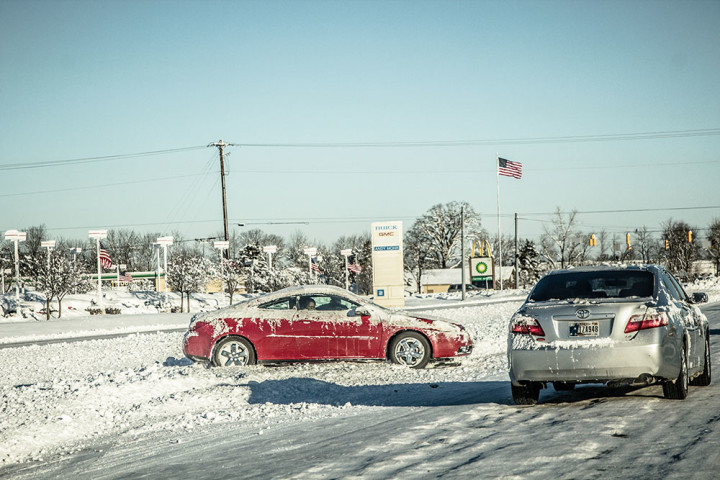By Nancy Edwards
Last week’s winter storm that blanketed central Indiana with up to a foot of snow in some locations is arguably the worst weather seen here in decades.
Snow began to fall Jan. 5 at the rate of 1 to 1 ½ inches per hour. Temperatures plunging well below zero froze efforts to revive the area for days.
A travel warning was issued and visibility was reduced to ¼ to ½ mile. In Hamilton County, the number of those without power rose dramatically from 180 residents to 3,000 in less than a day.
Refuge from shelters
Those affected by power outages were offered temporary refuge at Carmel High School. When the number of residents without power grew by the thousands in Noblesville and Fishers, a second shelter was opened at Fall Creek Intermediate School. However, many residents who owned pets were reluctant to leave them behind.
After the shelter at Fall Creek Intermediate closed its doors on the morning of Jan. 7, a shelter that welcomed residents with pets opened that afternoon at Hamilton County 4-H Fairgrounds.
“It was a reality; people weren’t leaving because of their pets,” said Thomas Sivak, executive director of Hamilton County Emergency Management. “Those without power had gone more than 12 hours or longer. Temperatures could be as low as 23 degrees.”
Rebecca Stevens, Executive Director of the Humane Society of Hamilton County, reiterated the importance of keeping pets inside.
“With temperatures as frigid as they are, a dog house doesn’t matter. That’s not enough. Any bowl of water outside is going to freeze. If it’s too cold for you to be outside, it’s too cold for them,” she said.
Frigid temps and bodily harm
With temperatures plunging well below zero after the storm, frostbite was a concern as drivers slid off icy roads into snowdrifts, waiting for an ambulance to arrive, according to Bill Bean, ER physician for Riverview Hospital in Noblesville.
“It’s certainly something we’re dealing with this week,” Bean said. “A lot of (drivers) are in unplanned exposures, getting stuck in vehicles outside when that wasn’t their intention.”
Some people also may be unaware that being outside for longer than 10 minutes without being fully protected can lead to frostbite, according to Catherine Michael, physician for St. Vincent Hospital in Fishers.
“Respect the weather; be aware that the amount of time spent outside is limited,” she said. “It’s highly dependent on temperatures and extreme wind chills.”
Michael also encourages residents anxious to start shoveling their driveway to take precautions, particularly if they are out of shape or older.
“I saw one patient who had a heart attack from shoveling snow,” Michael said. “It’s a very common event.”
In addition, Michael advised practicing safety measures when using electric devices such as snow blowers.
“Someone stuck their hand in to relieve a clog,” she said of a recent patient. “Never do any troubleshooting without taking your hand out first.”
As temperatures get warmer and people come out of hibernation, they should still use extreme caution when walking, according to Bean.
“There are still slick points on the sidewalk and on the road,” he said. “Those are when we really see falls; everyone is back up and around and forgetting to use caution.”
On the mend
Initially, some drivers were still on the roads the day the winter storm arrived, which caused difficulty with plowing the streets, according to Autumn Gaisor, Director of Public Relations for the Town of Fishers.
“We were ordering people to please stay off the streets,” she said. “That’s partly why travel warnings are in place, so we can effectively clear the roads.”
However, just a few days later, the Town of Fishers Department of Public Works had removed snow from almost 100 percent of the roads, according to Fishers Town Manager Scott Fadness.
“DPW has been working around the clock and done a remarkable job,” Fadness stated. “The severity of the storm and extreme temperatures have proven challenging, but DPW continues to push forward and is close to completion.”
From the beginning of the snowstorm through Jan. 8, Fishers had plowed 37,472 total miles of roads, delivered 2,045 tons of salt through snow trucks and dispersed 22 bags of salt on sidewalks, according to Gaisor. In addition, the wages for drivers working around the clock, including overtime, totaled $71,489.
Although most local businesses and schools were ordered to close while the snow trucks were on the road, Dan Canan, president/CEO of the Fishers Chamber of Commerce, was optimistic that the weather did not hurt the economy. In fact, he said, there was an increase in business at certain locations.
“Grocery stores have seen a surge in business; any auto repair, auto parts stores seem to be very busy on Monday,” Canan said. “For every one negative impact on a business there’s been a positive impact.”
As a result of DPW’s success, area schools were expected to open Jan. 9. The Indiana DOE informed schools that no make-up days were required for Jan. 6 and 7 if they submit a waiver.
Not out of the woods yet
Thawing temperatures will bring relief to residents, but we’re not out of the woods just yet. The melting snow is likely to lead to flooding, a critical issue facing the county.
“We’ll have to monitor (the forecast) as temperatures rise and snow melts,” said Hamilton County Sheriff Mark Bowen. “Highway department agencies are addressing those concerns with flooding.”

